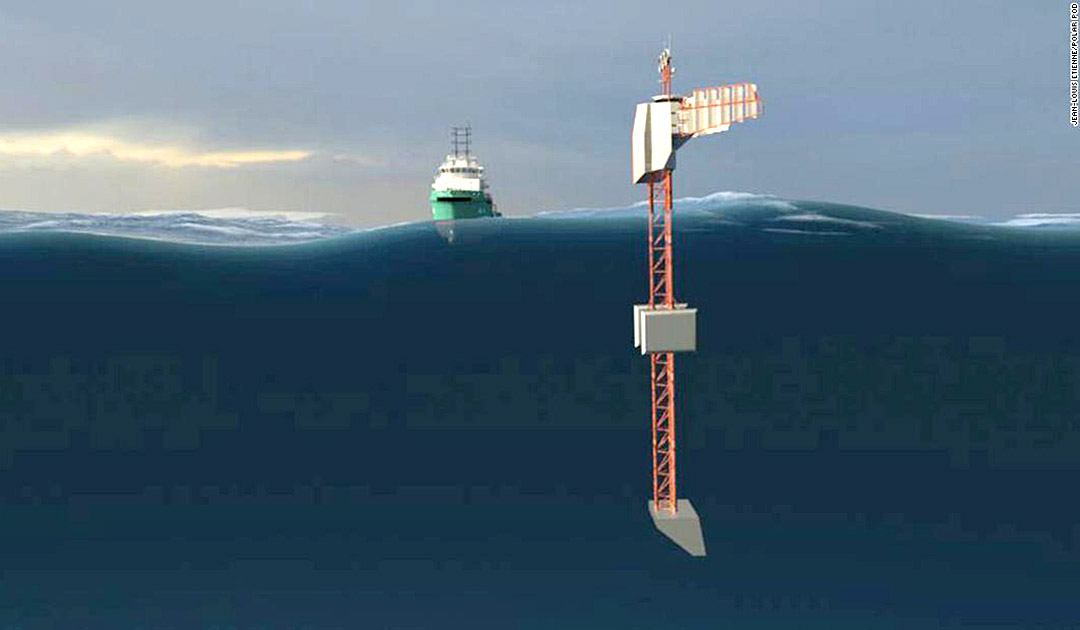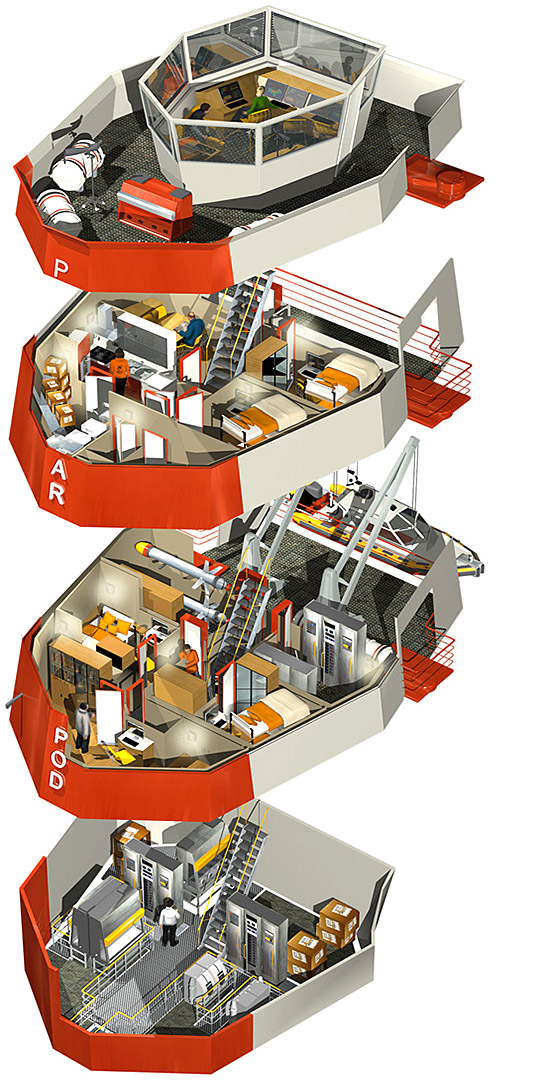
POLAR POD is a giant tower with a draft of 80 meters that will drift twice around Antarctica. Jean-Louis Étienne, initiator of this project, announces the official start of his next expedition. POLAR POD will be stabilized with 150 tons of ballast, which will provide the vertical position. The tower is powered solely by the wind and the current of the Circumpolar Current. Upstairs, a living unit will accommodate a crew of 8 on 4 floors. Every 2 months the crew is changed. At least, that’s the plan.

The goal of this scientific mission is to explore the Southern Ocean. POLAR POD’ will circumnavigate the Southern Ocean twice within three years.
The platform has no engine and is powered by the Antarctic Circumpolar Current, which drifts at about 1 knot per hour. The top of the structure – 20 meters above the water – is where the crew will live, sleep and work. ‘POLAR POD’ will enable the collection of long-term data and observations that will be transmitted to researchers, oceanographers, climatologists and biologists. The project involves 43 scientific institutions from 12 countries.
Because the structure is silent, it can use underwater microphones to record the “acoustic signature” of various sea creatures, from krill to whales, and conduct a census of marine life. It is also planned that the ship will help calibrate satellites for NASA and the European Space Agency.

Construction of the ‘POLAR POD
The question was: what type of ship would enable the “Furious Fifties” to provide working comfort and safety all year round? To escape the hustle and bustle of the waves, you need a boat with a large draft to escape the swell on the surface of the water. ‘POLAR POD’ is inspired by FLIP (Floating Instrument Platform), the American oceanic platform still in operation after 60 years of service to research.
Following the same principle, the ‘POLAR POD’ is towed horizontally to the study area and tilted into a vertical position by filling the ballasts with seawater.
Zero emissions
‘POLAR POD’ is an environmentally friendly platform. Powered by the Antarctic Circumpolar Current, ‘POLAR POD’ will have a very limited impact on the environment. The 4-storey nacelle is located 15 m above the surface and can accommodate 8 people autonomously for 6 months. To power scientific equipment, lighting, telecommunications, IT, seawater desalination, hot water and cooking, energy is generated by four 3.2 kW wind turbines and photovoltaic cells. It is stored in two lithium-ion battery packs of 50 kWh each. The ‘POLAR POD’ is a “zero-emission ship”.

Very stable at sea
‘POLAR POD’ is much more stable and comfortable than a conventional vessel. With a draft of 75 meters, this “vertical ship” is very stable. This should not exceed 5° of list in the mean weather of the Southern Ocean and a vertical movement of 10%.
The architecture is designed not to resonate with the swell. Its stroke time, the movement from bottom to top, is 60 seconds, while the swell in the deep south is almost 20 seconds.
Scientific program
POLAR POD’ will follow the current and winds of the Antarctic Circumpolar Current during its drift. Without motorization it is a silent ship. Thanks to its stability, it does not disturb the sea surface or the surrounding air. For all these reasons, this platform is specially adapted for:
- Air-sea exchange measurements, especially CO2 to assess its role in climate,
- Wave Dynamics,
- Monitoring and studies of current vortices,
- Plankton collections and assessment of acidification impacts,
- Acoustic inventory of marine fauna: marine mammals, krill, and ocean sounds,
- Validation of satellite measurements at sea: ocean colour, wave height, wind and current speed, etc.
- Aerosol measurements and their sources,
- Aerial observation of marine fauna, whales, sea birds.
If all goes well, the launch will take place in 2024.
Construction of ‘POLAR POD’ has not yet started, but is being funded by the French government. The French Oceanographic Institute ‘Ifremer’ will invite tenders for the construction of the ship.
Etienne is in the process of raising funds for a three-year expedition he hopes will begin in 2024. He can’t name the cost or the money raised so far.
Website of the expedition ‘POLAR POD
Heiner Kubny, PolarJournal





